Uni High Students Experience Math Research During IGL’s Summer Program
June 25, 2020
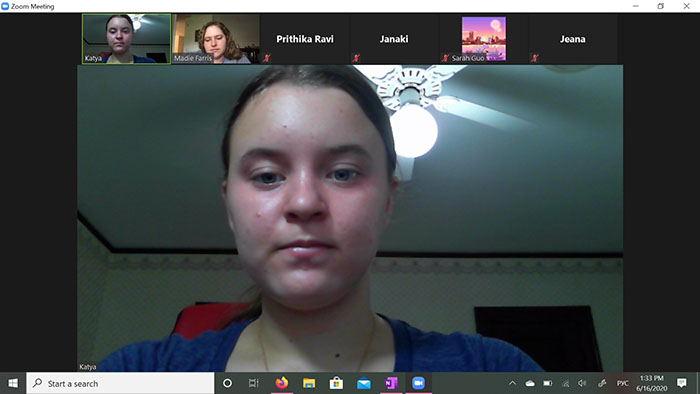
Uni High student Katya Sakhartova and the other members of Madie Farris' group during a Zoom meeting. (Image courtesy of Katya Sakhartova.)
This year’s IGL-Uni High Summer Program was virtually the same as last year’s…except that, due to COVID-19, it was done virtually—via Zoom instead of at Altgeld Hall. The idea behind the program was to introduce students from University Laboratory High School (Uni High) to math research, with the goal of demonstrating to 21 rising sophomores, juniors, and seniors that math research, such as that done at Illinois Geometry Lab (IGL), is quite different from the math K–12 schools do in class. Mentored by Illinois Math graduate students or post docs who are part of IGL, the high schoolers not only discovered what research is like while addressing specific areas of mathematics, but networked with math PhD students, many of whom wanted to pay it forward. Plus, they learned a bit about what being a math graduate student at Illinois is like.
In its third year, the program ran for four weeks, from May 27th through the final, end-of-program Zoom meeting held on June 25th, 2020. As in years past, the program was funded by Uni High alumnus David Frankel, the CEO of ZipDX LLC, whose contribution supported the collaboration between the school and the IGL. Also similar to last year, Philipp Hieronymi, Director of the IGL, and Ioana Boca, a Uni High math teacher, administrated the program. The IGL leadership team, which consisted of Hieronymi and several grad students, selected the grad students based on their responses to IGL’s call for applications. Regarding how Uni High participants were chose, Boca called for applications from among the school’s students. Then, prior to meeting with Hieronymi and the grad student team leaders to decide on the group assignments, she approached fellow Uni High math teachers to discover students’ interests and strengths. This year, everyone who applied was accepted.
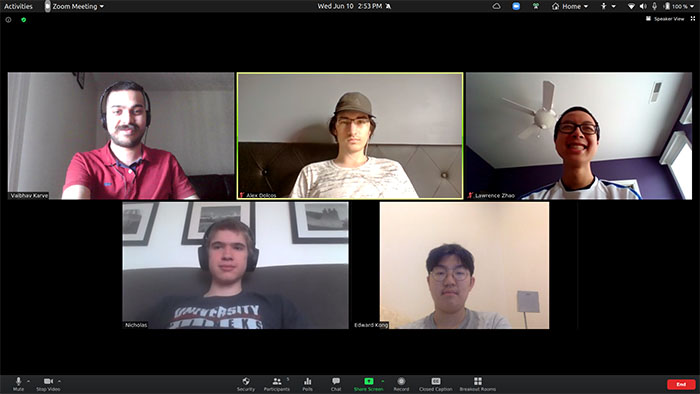
Fifth year Math PhD student Vaibhav Karve (top left) meets with his team of Uni High students via Zoom. (Image courtesy of Vaibhav Karve.)
Divided into five different research groups, each led by a different grad student (and one post doc), the students researched the following topics: classes of finite, simple, undirected graphs; combinatorial game theory; exploring algorithms; geometric group theory; and computer-assisted mathematical proof. According to Hieronymi, the grad students themselves came up with the projects. He just made sure the projects were sensible for high schoolers, particularly if a grad student was involved with the program for the first time. “But as in previous years, the proposals and ideas are truly theirs,” he asserts. “I remain completely impressed how well their ideas work. They are on the same level as projects proposed by faculty (in some instances even better!)”
The high school students were expected to work in a group with their team leader for around nine hours per week, plus spend around the same amount of time working on their own outside these group meetings. Each group was expected to produce five products. Ccreated at their first meeting was 1) a contract of sorts, which designated their project goals;, which team member would do what, according to their strengths; and a schedule of their weekly meetings. Additionally, they were to produce 2) a brief description of their research aimed at piquing the interest of a general audience; 3) a detailed description of their research; 4) a poster to be presented at the end of the program, plus at IGL’s December Open House; and finally, 5) a short slideshow presentation summarizing their research results, to be used in a video about their project which they were to present at the end-of-the-program Zoom meeting on June 25th. This was held at 5:00 pm so parents, siblings, and other interested persons could participate. In fact, among the 40+ Zoom participants was funder David Frankel, whose supprt went beyond just financial. For those who missed the final meeting, the five team's presentations may be found here.
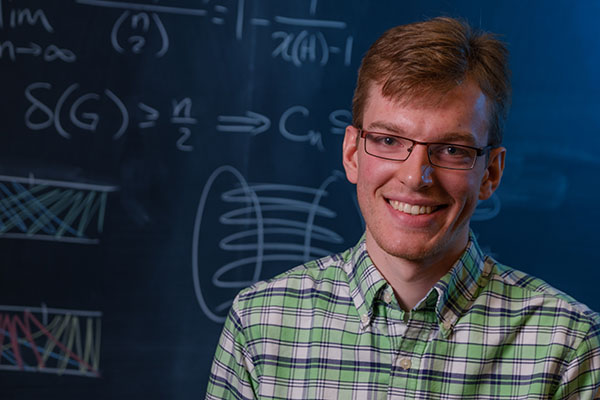
Robert Krueger, leader of the games theory research project. (Image courtesy of Robert Krueger.)
Team leaders ranged from a first-year grad student to a post-doc who had just finished her PhD. For example, one mentor, Bob Krueger, had just finished his first year of grad school. His research in extremal combinatorics answers questions of the form "What's the worst/best something can be, given some constraints, and what do those optimal objects look like?" when applied to discrete systems (systems whose pieces can be enumerated). Krueger heard about the IGL-Uni High program through his work as an IGL mentor in the spring 2020 semester, reporting: “I had a similar experience when I was in high school that really impacted me positively, so I wanted to pay it forward to a new set of high school students. Also, I was not daunted by the online approach this summer, since the IGL project I worked on had successfully transitioned online.”
The research project Krueger’s group tackled involved looking at games with no random elements, with the goal of finding out how to win at them! “Specifically, we will be learning about the theory of these games, and we'll see how we can push this theory towards some unsolved games,” he claims.
Weihang Wang, who’s in her third year, and whose research involves a mixture of combinatorics and algorithms, says her team mainly worked on minimum Wiener connectors. Wang got involved for two reasons. “First, I worked as a team leader last year; second, it is nice to have a variety of stuffs to do during lock-down,” she explains.

Hejoung Kim (top center) and the Uni High students on her team during a Zoom meeting. (Image courtesy of Hejoung Kim.)
Another mentor, Dr. Hejoung Kim, just finished her sixth year in Math’s PhD program and defended in April 2020. Her research interest lies in geometric group theory, an area in math that explores the connection between geometry and algebra.
Kim had been an IGL mentor with a faculty member’s supervision and had really enjoyed working with undergraduate students and sharing ideas. Based on the experience, she decided she’d like to lead her own research project, and the Uni High Research program gave her that opportunity.
“In addition,” she says, “I would like to introduce young students to actual mathematical research and encourage them to approach mathematics in a different way from classrooms at school.”
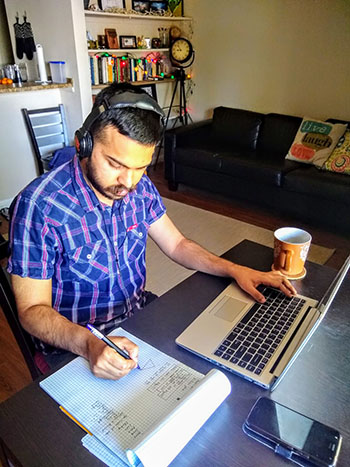
Vaibhav Karve meeting with his group. (Image courtesy of Vaibhav Karve.)
Her group learned geometric group theory via various examples and explored challenging and open problems in the area, plus did some programming for the problems.
Leading the group that taught Euclidean Geometry to a computer was 5th year Math PhD student Vaibhav Karve. His group used an interactive software, the Lean Theorem Prover, to translate mathematics into computer code that can then be vetted and certified by a computer. This allowed them to prove mathematical theorems with absolute certainty and no human errors. Karve reports that he uses code in computers and drawings that he makes by hand to solve logic-related problems as part of his research at the intersection of Computational Mathematics, Graph Theory, and Logic.
Karve, who has previous experience leading IGL research projects with Illinois undergraduates, and who has also taught mathematics to high-school students as part of Math’s annual Summer Illinois Math Camp, shares why he got involved in the Uni High Research Experience Program. He calls it a good way to “combine mathematical research with my interest in fostering math awareness in younger age-groups. This project lets me share my love for the subject with the enthusiastic students at Uni High. It is a good way to show them what research math feels like and how it is so different from math one might learn in a classroom setting.”
Leading "The Hunt for Great Graphs" was Math PhD student Madie Farris. This project built on work done by a couple previous IGL projects on the topic of “Pairs of Disjoint Matchings.” Their group focused on studying certain parameters of finite, simple, undirected graphs. They provided a constructive proof of the existence of families of graphs which attain certain bounds given by these parameters.
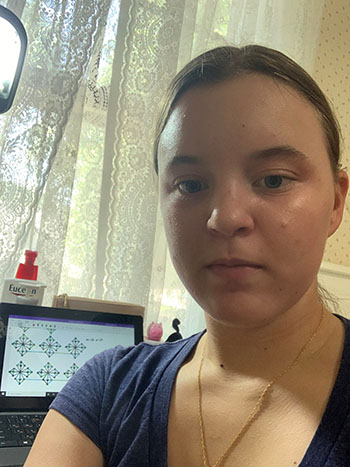
Katya Sakhartova. (Image courtesy of Katya Sakhartova.)
A couple of the 21 Uni High students who participated in the program share why they got involved and how they benefitted. For instance, one student, Katya Sakhartova, a rising junior, indicates that she chose to participate because she enjoys math and thought it would be interesting to learn math outside of a school environment. “I was also excited to be able to do math research and learn more about the research process," she adds.
For Sakhartova, who was a member of Madie Farris' team which studied graph theory, she shares that the most challenging part of the program was developing a strategy to prove the conjecture. “There were times when the strategy I tried didn’t work or only worked for a certain group of graphs,” she explains. “From there, I had to be able to figure out what to do so that my work helped prove the conjecture.”
She reports that another challenging part of this program was working online. Because of COVID-19, her group wasn't able to meet in person, which she says made it harder to collaborate with her group members and share their progress with each other.
Sakhartova claims that she particularly enjoyed that the research covered math not addressed at school. “I really liked exploring math outside of school since we got to cover topics that aren’t included in the normal curriculum,” she says. “School math is usually limited to learning a concept, answering questions about it, and eventually having a test. Sometimes, there might also be some proofs sprinkled into the curriculum. The IGL program, on the other hand, has allowed me to explore more and play around with math.”

Hejoung Kim's group present their project on Geometric Group Theory during the June 25th final presentation. Watching via Zoom are the key players, including Hieryonimi, Boca, the five team leaders, and funder David Frankel.
Sakhartova asserts that she enjoyed the research program. “The program isn’t as rigidly structured as school math classes,” she acknowledges, “and the math itself is very exploration based. For example, my project is more about finding patterns, so I have had to draw tons of graphs and notice connections between them.” She adds that the IGL program also allowed her to explore the math research process, plus she also learned skills she wasn’t expecting to learn, such as how to write math in LaTeX. “Overall, I think being involved in this program has been a great experience for me, and I have learned a lot,” she continues.
Another Uni student, rising senior Collin Jung, shares why he got involved with the program. “I'm interested and passionate about mathematics and feel fortunate that Uni offers this program in the summer,” Jung explains. “I participated in this program because I wanted to ‘keep in touch’ with math during break.”
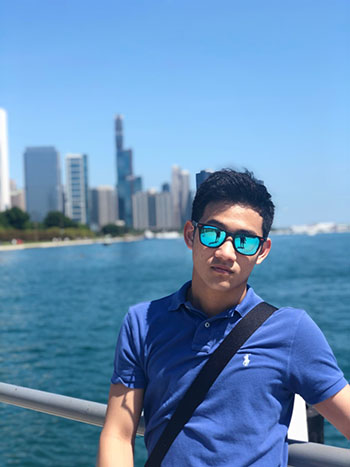
Uni High rising senior Collin Jung. (Image courtesy of Collin Jung.)
Plus, he had participated last year, and knew how beneficial the program was. “I was a participant last year and had a very memorable experience which allowed me to explore aspects of mathematics that I had not previously studied before,” he recalls.
One thing Jung found particularly challenging was the communication aspect of the program–reporting on his research. “Although I've already encountered some of the material from my project this year, being able to put that knowledge together into a coherent report/presentation was difficult for me,” he acknowledges. “Of course, I guess you can't really understand anything fully until you can explain it to someone else.”
Jung indicates that the thing he found to be the most beneficial about the program was being in small groups, which, “allows for a constant sense of community and support so that no one feels uncomfortable bringing up the fact that they might not understand something,” he admits. “Additionally, the team leader provides a lot of help and leadership over the course of the program.”
Regarding the IGL-Uni High Summer Program’s impact, Jung believes that, because of the experiences the students gain, it’s great for those who want to pursue a future that focuses on research or mathematics. “Since the students explore parts of math that they have probably not learned about before,” he maintains, “it allows for a wider range of knowledge for that student. I hope that future students can have the same memorable time during this program as I had.”
Regarding the goal and hoped-for impact of the program, Hieronymi indicates that there are numerous reasons why high school students benefit by participating in research projects. “One is to instill excitement for STEM fields in these highly talented students,” he says, “and to make them consider mathematics (or STEM fields in general) as a career option.”
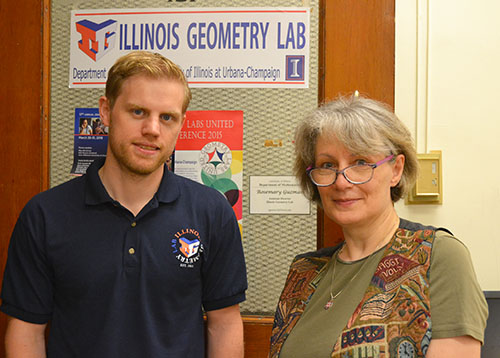
IGL Director and Math Associate Professor Philipp Hieronymi and Uni High teacher Ioana Boca during the program's 2019 poster session at IGL.
But for students who have already decided to pursue such a career, he claims that research experiences are invaluable. “Many of them have the talent and drive to become future leaders of their chosen field,” says Hieronymi. “Fostering their talent through hands-on experience early on is in our society's best interest.” He goes on to liken the search for the next great mind to the search for the next superstar in sports. “After all, there are so many programs to find and support the next sport super stars (the next Michael Jordan, the next LeBron James, or the next Mike Trout). Why shouldn't we do the same to find the next Albert Einstein or Terence Tao?”
Story by Elizabeth Innes, Communications Specialist, I-STEM Education Initiative. Photographs by Elizabeth Innes unless noted otherwise.
More: 8-12 Outreach, High School Research, Illinois Geometry Lab, Math, University Laboratory High School, 2020
For more articles about Illinois Geometry Lab, please see:
- The Illinois Geometry Lab Partners with Uni High to Expose Students to Research
- Local Girls Make Strides In Mathematics During AWM’s Sonia Math Day
- IGL Links Central High Students to the More Knotty Aspects of Mathematics
- Illinois Geometry Lab: Changing the Shape of Math Research...and Outreach
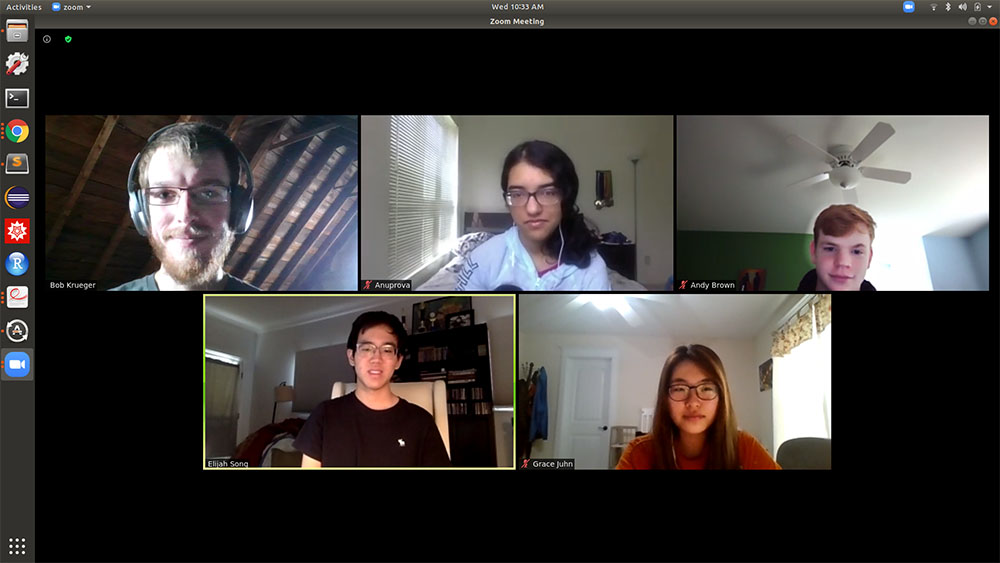
Bob Krueger's team meeting on Zoom. (Image courtesy of Bob Krueger.)













.jpg)
















